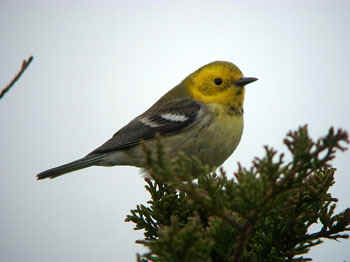 Hermit Warbler, Dendroica occidentalis, Jones Beach State
Park, Nassau Co., NY, 30 November 2002.
Hermit Warbler, Dendroica occidentalis, Jones Beach State
Park, Nassau Co., NY, 30 November 2002. Hermit Warbler, Dendroica occidentalis, Jones Beach State
Park, Nassau Co., NY, 30 November 2002.
Hermit Warbler, Dendroica occidentalis, Jones Beach State
Park, Nassau Co., NY, 30 November 2002.
All pictures are © Kevin and Jay McGowan. They were taken with an Olympus D-40 digital camera through a Swarovski HD-80 spotting scope. The video captures were taken with a Sony TRV830 video camera.
Found on Thursday, 28 Nov. 2002 by Andrew Block near the Boardwalk Restaurant at Jones Beach State Park, Nassau County, New York. For more photos of this bird, go to Seth Ausubel's page <http://home.nyc.rr.com/sausubel/page2.html> or Angus Wilson's <http://www.oceanwanderers.com/HermWarbNY02.html>.
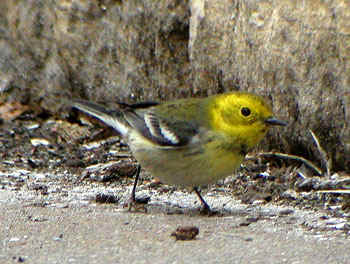
The bird resembled a female or hatch-year male Black-throated Green Warbler (Dendroica virens), but had several differences. The most obvious was the very yellow face with only a relatively faint dusky mask around the eye and auriculars. In Black-throated Green Warbler this area appears as a darker line extending through the eye, with a clear yellow crescent below the eye. (The line through the eye is even more distinct in the similar Townsend's Warbler, D. townsendi, and Golden-cheeked Warbler, D. chrysoparia.) Hermit Warbler has a clear yellow eyering in all plumages, as did this bird.
Also differing from Black-throated Green and Townsend's warblers, the dusky on the crown did not reach the bill and the forehead was yellow. Only very thin flank streaking was present instead of the broader and darker streaks of the other species. The back was grayish olive, with distinct thin dark streaks. Black-throated Green Warbler has yellow across the vent, and that area on this bird was white.
Black feathers were present as an irregular patch at the base of the throat. When Black-throated Green and Townsend's warblers have limited black in their throats the black seems to be most prevalent at the sides, not the center, of the throat.
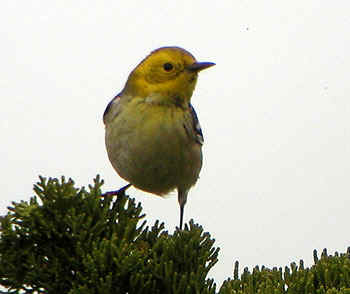 |
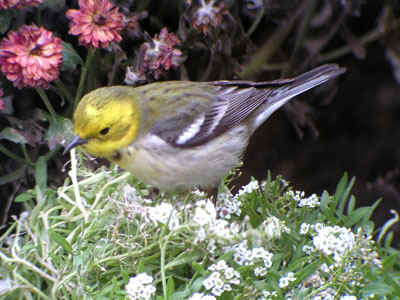 |
| This shot shows the olive and gray back. The feathers appear to me to be gray-based, with olive edges. They are a long way from the bright olive green back feathers of a Black-throated Green Warbler |
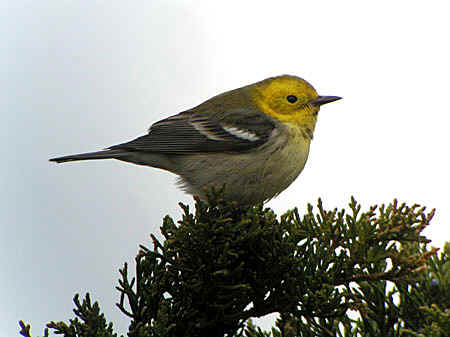 |
| Notice the very thin flank streaking in this shot. |
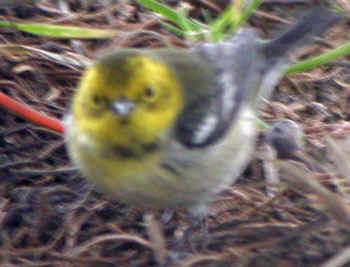 |
| This blurry photo shows the yellow eyerings pretty effectively. Note also the asymmetrical dark head patterning with the yellow extending farther up the crown on its left side. |
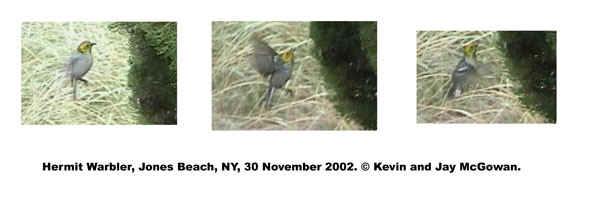
The bird spent quite a bit of time foraging in some small conifers, often hovering to glean insects off the surface of the trees, as shown by these video captures. It never sat still the entire time we watched it, but instead actively foraged through a variety of vegetation, mostly in rather deep cover.
|
|
|
This video capture shows the extensive white outer tail feathers. Both the outermost (r6) and r5 were nearly entirely white. Unfortunately, we did not manage to get a picture of r4, which might have assisted in aging the bird. Note also the upper tail coverts that are predominantly black, with light edges. |
This video capture shows the distinct streaks down the olive-gray back, and shows the extent of the yellow up onto the crown. |
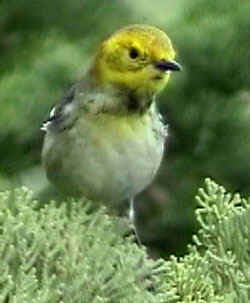 |
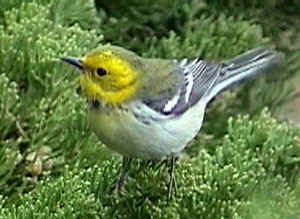 |
| This video capture shows the bird with its neck slightly extended, maximizing the effect of the dark throat. | The throat usually appeared as a small dark spot or crescent, as in this video capture. |
The greenish back, dark spotting on the crown, and especially the pale yellow wash on the chest under the black throat patch suggest mixed ancestry, with some influence of Townsend's Warbler (D. townsendi). In Rohwer and Wood's article (see below) about these hybrids they calculated hybrid scores for breeding males using 7 characters (mid-flank streaking; lower flank streaking; black at the bib corners; distance of yellow below the black bib; intensity of the yellow at the edge of the bib; amount of black on crown, and amount of green on the back). They chose to normalize each character so that no one character would too heavily influence the score.
Although this bird might have some Townsend's genes in its ancestry, it seems to be mostly Hermit Warbler.
| For more information on Hermit X Townsend's warbler
hybrids, look at these references: Jackson, W. M., C. S. Wood, and S. Rohwer. 1992. Age-specific plumage characters and annual molt schedules of Hermit Warblers and Townsend's Warblers. Condor 94: 490-501. For a pdf file of this article, go to http://elibrary.unm.edu/Condor/; or directly to http://elibrary.unm.edu/Condor/files/issues/v094n02/p0490-p0501.pdf. This service is sponsored by the Cooper Ornithological Society. Rohwer, S. and C. Wood. 1998. Three hybrid zones between Hermit and Townsend's warblers in Washington and Oregon. Auk 115: 284-310. |
Return to the Bad Photos page.
Return to Kevin McGowan's home page.
Go to the Crow Page.
Go to the Cornell Lab of Ornithology's home page